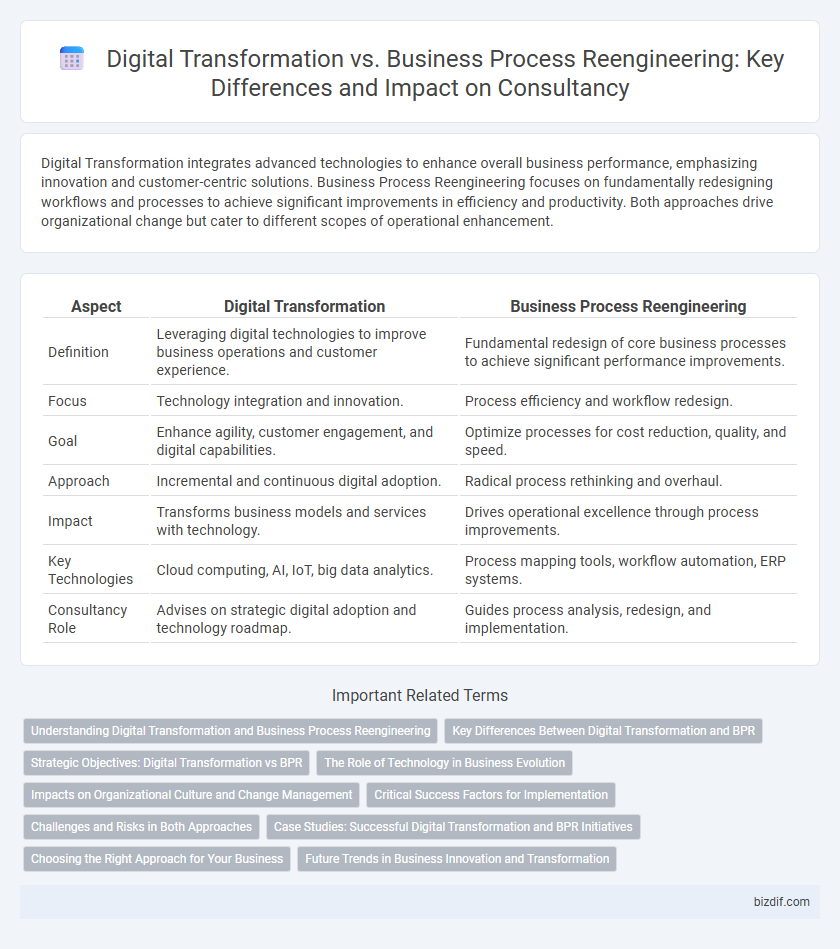Digital Transformation integrates advanced technologies to enhance overall business performance, emphasizing innovation and customer-centric solutions. Business Process Reengineering focuses on fundamentally redesigning workflows and processes to achieve significant improvements in efficiency and productivity. Both approaches drive organizational change but cater to different scopes of operational enhancement.
Table of Comparison
| Aspect | Digital Transformation | Business Process Reengineering |
|---|---|---|
| Definition | Leveraging digital technologies to improve business operations and customer experience. | Fundamental redesign of core business processes to achieve significant performance improvements. |
| Focus | Technology integration and innovation. | Process efficiency and workflow redesign. |
| Goal | Enhance agility, customer engagement, and digital capabilities. | Optimize processes for cost reduction, quality, and speed. |
| Approach | Incremental and continuous digital adoption. | Radical process rethinking and overhaul. |
| Impact | Transforms business models and services with technology. | Drives operational excellence through process improvements. |
| Key Technologies | Cloud computing, AI, IoT, big data analytics. | Process mapping tools, workflow automation, ERP systems. |
| Consultancy Role | Advises on strategic digital adoption and technology roadmap. | Guides process analysis, redesign, and implementation. |
Understanding Digital Transformation and Business Process Reengineering
Digital Transformation involves leveraging advanced technologies like AI, IoT, and cloud computing to fundamentally change how businesses operate and deliver value to customers. Business Process Reengineering focuses on analyzing and redesigning core business processes to achieve significant improvements in productivity, efficiency, and quality. Understanding the nuances of both approaches helps organizations choose the right strategy to drive innovation and competitiveness in the digital era.
Key Differences Between Digital Transformation and BPR
Digital Transformation involves leveraging advanced technologies such as AI, cloud computing, and IoT to fundamentally change business models and customer experiences, while Business Process Reengineering (BPR) focuses on analyzing and redesigning core business processes to achieve significant performance improvements. Digital Transformation emphasizes innovation, agility, and integrating digital tools across all organizational levels, whereas BPR targets process efficiency and cost reduction through radical rethinking of workflows. Companies undertaking Digital Transformation aim for long-term cultural shifts and competitive advantage, whereas BPR projects are typically shorter-term, process-centric initiatives.
Strategic Objectives: Digital Transformation vs BPR
Digital Transformation aims to leverage emerging technologies to create new value propositions, enhance customer experiences, and enable agile business models aligned with long-term innovation goals. Business Process Reengineering (BPR) focuses on fundamentally redesigning core business processes to achieve dramatic improvements in cost, quality, service, and speed. Strategic objectives of Digital Transformation emphasize continuous adaptation and digital integration, while BPR targets radical process efficiency and operational performance enhancements.
The Role of Technology in Business Evolution
Digital transformation leverages emerging technologies such as AI, cloud computing, and IoT to innovate and streamline business operations, driving continuous evolution and competitive advantage. Business process reengineering focuses on fundamentally redesigning workflows and processes to achieve dramatic improvements in performance, often enabled by technology integration. Both approaches rely on technology as a catalyst for change, yet digital transformation emphasizes ongoing adaptation while reengineering targets foundational process overhaul.
Impacts on Organizational Culture and Change Management
Digital Transformation reshapes organizational culture by fostering a mindset of continuous innovation and agility, while Business Process Reengineering (BPR) drives radical change through restructuring core processes, often resulting in significant shifts in employee roles and workflows. Change management in Digital Transformation emphasizes iterative adaptation and employee engagement to embed new technologies seamlessly, contrasting with BPR's more top-down, project-based approach that demands rapid acceptance of fundamental operational changes. Both strategies require tailored communication and leadership commitment to mitigate resistance and align workforce behavior with new strategic objectives.
Critical Success Factors for Implementation
Critical success factors for implementing Digital Transformation include strong executive sponsorship, agile change management, and robust technology integration strategies that align with business objectives. Business Process Reengineering requires thorough process analysis, clear communication across stakeholders, and continuous performance measurement to ensure effective redesign and operational efficiency. Both approaches demand a culture of innovation and employee engagement to drive sustainable organizational change and value creation.
Challenges and Risks in Both Approaches
Digital Transformation and Business Process Reengineering both face significant challenges, including resistance to change, high implementation costs, and potential disruption to existing operations. Digital Transformation risks include technology integration issues, cybersecurity threats, and data privacy concerns, while Business Process Reengineering often struggles with employee pushback and the complexity of redesigning entrenched processes. Effective risk management requires thorough stakeholder engagement, clear communication strategies, and iterative testing to mitigate potential failures in both approaches.
Case Studies: Successful Digital Transformation and BPR Initiatives
Successful digital transformation initiatives often leverage advanced technologies such as artificial intelligence, cloud computing, and data analytics to enhance customer experiences and operational efficiency, as demonstrated in case studies from industries like retail and finance. Business Process Reengineering (BPR) case studies highlight radical redesigns of core processes, resulting in significant reductions in cycle time and costs, exemplified by manufacturing firms streamlining supply chain management. Combining digital transformation with BPR has proven effective in driving sustainable growth, with case studies emphasizing the critical role of leadership commitment and cross-functional collaboration.
Choosing the Right Approach for Your Business
Selecting between Digital Transformation and Business Process Reengineering depends on your company's objectives and existing workflow challenges. Digital Transformation integrates advanced technologies like AI, IoT, and cloud computing to enhance customer experience and operational agility. Business Process Reengineering focuses on fundamentally redesigning core processes to achieve dramatic improvements in productivity and efficiency, making it ideal for businesses with outdated or inefficient systems.
Future Trends in Business Innovation and Transformation
Digital Transformation leverages emerging technologies such as AI, IoT, and cloud computing to create agile, data-driven business models that enhance customer experience and operational efficiency. Business Process Reengineering focuses on fundamental workflow redesign to eliminate inefficiencies and achieve radical performance improvements, often requiring cultural and organizational change. Future trends emphasize the integration of intelligent automation and real-time analytics, enabling continuous adaptation and innovation in dynamic market environments.
Digital Transformation vs Business Process Reengineering Infographic

 bizdif.com
bizdif.com